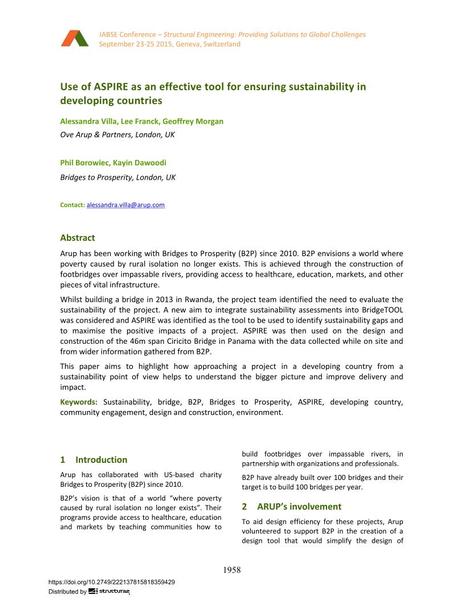Use of ASPIRE as an effective tool for ensuring sustainability in developing countries

|
|
|||||||||||
Bibliographic Details
| Author(s): |
Alessandra Villa
(Ove Arup & Partners, London, UK)
Philip Borowiec (Bridges to Prosperity, London, UK) Kayin Dawoodi (Bridges to Prosperity, London, UK) Lee Franck (Ove Arup & Partners, London, UK) Geoffrey Morgan (Ove Arup & Partners, London, UK) |
||||
|---|---|---|---|---|---|
| Medium: | conference paper | ||||
| Language(s): | English | ||||
| Conference: | IABSE Conference: Structural Engineering: Providing Solutions to Global Challenges, Geneva, Switzerland, September 2015 | ||||
| Published in: | IABSE Conference Geneva 2015 | ||||
|
|||||
| Page(s): | 1958-1964 | ||||
| Total no. of pages: | 7 | ||||
| Year: | 2015 | ||||
| DOI: | 10.2749/222137815818359429 | ||||
| Abstract: |
Arup has been working with Bridges to Prosperity (B2P) since 2010. B2P envisions a world where poverty caused by rural isolation no longer exists. This is achieved through the construction of footbridges over impassable rivers, providing access to healthcare, education, markets, and other pieces of vital infrastructure. Whilst building a bridge in 2013 in Rwanda, the project team identified the need to evaluate the sustainability of the project. A new aim to integrate sustainability assessments into BridgeTOOL was considered and ASPIRE was identified as the tool to be used to identify sustainability gaps and to maximise the positive impacts of a project. ASPIRE was then used on the design and construction of the 46m span Ciricito Bridge in Panama with the data collected while on site and from wider information gathered from B2P. This paper aims to highlight how approaching a project in a developing country from a sustainability point of view helps to understand the bigger picture and improve delivery and impact. |
||||
| Keywords: |
bridge sustainability design and construction environment community engagement Bridges to Prosperity developing country B2P ASPIRE
|
||||
